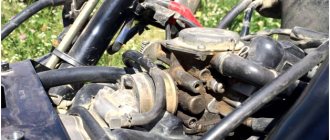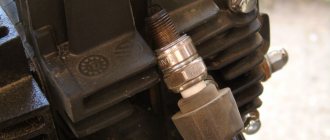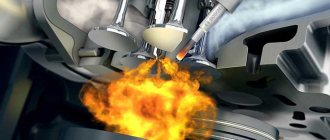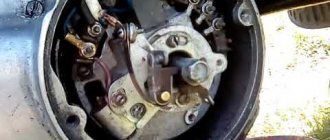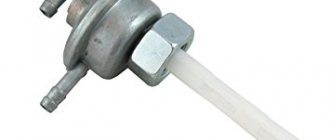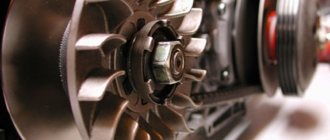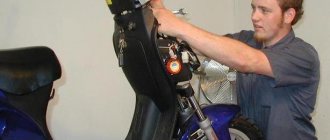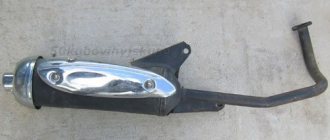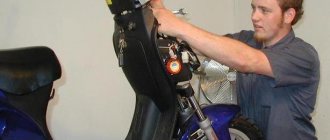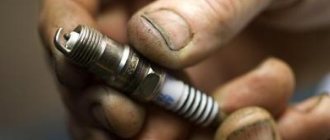shoot into the muffler on cars with both carburetor and injection engines. At the same time, oddly enough, the muffler itself has nothing to do with it. It is only a source of sound, and the factors causing loud sounds lie in completely different parts of the car.
Most often, the causes of popping sounds in the muffler are malfunctions of the ignition system , fuel supply or gas distribution system. Next, we’ll figure out how to get rid of the problem when it shoots into the exhaust pipe , and what you need to pay attention to first of all during “explosions.”
Why does it shoot at the silencer?
The main reason that the engine shoots into the muffler is unburned fuel that has entered the exhaust system and ignited in it. The greater the amount of gasoline that has leaked out, the louder the bang will be, and in some cases there may even be a whole series of “shots.” In turn, fuel can enter the exhaust system for various reasons. These could be malfunctions of the carburetor, timing belt, ignition system, various sensors (on injection machines) and so on.
The situation when someone shoots into the exhaust pipe can occur under different circumstances. For example, when over-accelerating, at idle speed of the engine or when relieving gas. As a rule, when there is a bang, a large amount of smoke . This malfunction is also accompanied by additional symptoms - loss of engine power, floating idle speed, increased fuel consumption. Let's look at the reasons why the muffler shoots in order, as well as methods for troubleshooting.
Clogged air filter
Air filters
One of the reasons why muffler pops is an incorrectly formed fuel mixture. To create it, you need gasoline and a certain amount of air. It enters the engine through a system that contains an air filter at the inlet. If it is clogged, it does not allow a sufficient volume of air to pass through it, so the result is a kind of “oxygen starvation” of the engine. As a result, gasoline does not burn completely , and some of it flows into the manifold and then enters the exhaust gas removal system. There the fuel heats up and explodes. Because of this, a kind of pop is produced in the muffler.
Eliminating the cause of this phenomenon is not difficult. It is necessary to check the condition of the air filter and replace it if necessary. This is especially true if you haven’t changed the filter for a long time, but according to the regulations, such a procedure already needs to be done. This is the simplest problem why the muffler shoots. Let's move on.
The main reasons for the problem
Popping noises in the muffler can occur for the following reasons:
- Explosion of a flammable mixture that did not have time to burn during the operating cycle. Such pops can occur in systems with both a carburetor and an injector.
- Valve timing mismatch.
- The car air filter is dirty.
- Failure in the size of the thermal gap on the cylinder head valve (if the problem appears at high or low speeds).
- Late ignition is also a common reason why the muffler shoots. In this case, it is inevitable that some amount of fuel will be released into the collector.
- Spark too weak. This may be due to problems with spark plugs, toggle switches, contact groups, and wire contacts.
- Timing belt stretching. In this case, shots are heard only when the system is warmed up, and not immediately when you press the gas.
- Popping noises in the injector may be due to insufficient reliability of the sensor contacts.
If the muffler slams, it is undesirable to use the car. The maximum is to get to a car service center. Ignoring lumbago for a long time will lead to serious engine damage.
There is another possible reason why the muffler fires - the use of low-quality fuel with a low octane number. In this case, it is enough to switch to more expensive gasoline.
Carburetor not tuned
Car carburetor
Often the reason that the engine shoots into the muffler is an incorrectly configured carburetor. Its task is to create a fuel-air mixture, which is then supplied to the engine. If it is configured in such a way that the mixture is oversaturated with gasoline, a situation similar to that described above is created. The solution here is to check and adjust the “carb”.
The first step is to check the fuel level in the chamber where the float is located. Each carburetor is individually adjusted and has its own level. However, if its cover is removed, the float should be flush with the level of the cover. If this is not the case, adjust the level. Also be sure to check the integrity of the float . If it is damaged, fuel may leak into it, causing it to display the level incorrectly.
The reason that the carburetor shoots into the muffler may also be the jets. They are either configured incorrectly or become clogged over time. If the air jet does not supply enough air, the mixture becomes oversaturated with gasoline with the result described above. Often this malfunction occurs when the engine goes from idle to higher speeds, or with a sharp increase in speed (acceleration). It is necessary to check the condition of the jets and clean them if necessary.
| Air/fuel ratio | Description | A comment |
| 6/1 — 7/1 | Extremely rich mixture. Ignition failure. | Rich mixture. Long burning, low temperature. |
| 7/1 — 12/1 | Overrich mixture. | |
| 12/1 — 13/1 | Rich mixture. Maximum power. | |
| 13/1 — 14,7/1 | Slightly enriched mixture. | Normal mixture. |
| 14,7/1 | Chemically ideal ratio. | |
| 14,7/1 — 16/1 | Slightly lean mixture. | |
| 16/1 — 18/1 | Poor mixture. Maximum efficiency. | Poor mixture. Fast combustion, high temperature. |
| 18/1 — 20/1 | Over-lean mixture. | |
| 20/1 — 22/1 | Extremely lean mixture. Ignition failure. |
Carburetor and pops
Quite often it happens that popping noises in the exhaust system begin due to the fact that the carburetor was incorrectly configured. Its job is to create the correct fuel-air mixture, which is then supplied to the engine. If it happens that after adjusting it, it saturates the mixture too much with fuel, that is, gasoline, then the same thing as described above will begin to happen. That is, popping noises will begin to occur in the muffler when gas is released from the carburetor system. Naturally, the only correct way out in such a situation would be to reconfigure this element.
The first thing to do in this case is to check the gasoline level in the chamber in which the special float is located
It is important to know here that each carburetor is adjusted individually, and therefore each has its own optimal level. However, there is one general feature: if you remove the cover, the float should be flush with the level of the cover
If this is not the case, then you need to make adjustments. In addition, you should immediately check the integrity of the float itself. If it has any deformations, this can lead to fuel getting inside it, and therefore it indicates the wrong gasoline level.
Another reason for popping noises in the muffler is the system jets. They may also be incorrectly configured or, if they have been in use for a long time, become dirty. In this case, the same thing will happen as happened with a dirty air filter. Jets are the same as air filters, with the only difference being that they are used in a carburetor system to create a mixture, and not in an injection system. Their clogging means that the amount of air entering the chamber decreases, and therefore the mixture becomes oversaturated with gasoline. Quite often, popping noises in the muffler at idle speeds occur after a sharp transition has been made from such speeds to higher speeds. In addition, the cause may be a sharp increase in speed, that is, excessive acceleration. If after any of these actions popping sounds appear, then you need to check the carburetor.
Faulty ignition system
Another reason that the fuel does not burn completely and popping sounds from the exhaust pipe can be heard is that the ignition is not set correctly. In particular, if the ignition is late , then popping noises in the muffler at idle and at high speeds are inevitable. This fact is very simple to explain. A situation occurs when a spark appears at the moment when the supply valve has already fully opened, as a result of which part of the fuel does not have time to burn, but leaks into the manifold. And if the ignition is “early” , then it will “shoot” at the air filter.
Late ignition can not only cause popping noises in the muffler, but also cause the intake valve to burn out over time. Therefore, do not delay with ignition adjustment.
Checking the spark plugs
Also, the cause of incomplete combustion of fuel can be a weak spark. In turn, this is a consequence of one of the facts:
- Poor contacts on high-voltage wires. It is necessary to inspect them and clean them if necessary. You should also check that there is no ground fault.
- Malfunctions in the operation of the distributor . It is also advisable to check its operation.
- Partially failed spark plugs . If at least one of them has exhausted its service life, this affects the power of the spark it produces. Because of this, not all fuel is burned. Check and replace spark plugs if necessary.
Use candles with the correct heat rating. This will provide the necessary and sufficient spark power to burn all the fuel.
Retarded ignition
Ignition settings if incorrectly configured can easily lead to similar problems. The system should be checked from the ignition timing angle - if it is delayed, then shots through the muffler cannot be avoided. The spark is delayed, causing some fuel to be sent to the manifold. As a result, you can get not only noise effects, but also valve combustion.
But why does it shoot at the muffler if the ignition settings are set correctly? In this case, the problem should be looked for in electrical engineering. Either the spark itself has a weak charge and the ignition of the combustible mass simply does not work, or there are faults in the contacts with the connection of the toggle switch. Problems are eliminated by a complete revision of the ignition system with a possible replacement of the contact group. At the same time, it doesn’t hurt to check the spark plug to see if it matches the engine’s heat rating and whether it’s in working condition in principle.
Incorrect thermal clearance
The thermal gap is the distance by which individual parts of the engine increase in volume when heated. In particular, it is between the valve tappets and the camshaft cams. An incorrectly set thermal gap is one of the possible reasons why the muffler shoots.
Indirect evidence of an increase in the thermal gap may be increased noise during engine operation, as well as a decrease in its power. If the gap is reduced, this may cause gases to shoot into the exhaust pipe. This occurs due to the fact that a valve that is not completely closed allows gasoline to enter the manifold, from where it then enters the exhaust system.
The thermal clearance of the cylinder head valves can be adjusted. Therefore, to eliminate this problem, it is enough to adjust the valves. This procedure is always carried out on a cold engine.
Faulty timing belt
Malfunctions in the operation of the gas distribution mechanism are generally similar to problems with ignition. In particular, the exhaust valve opens at a time when the gasoline has not yet burned out. Accordingly, it enters the exhaust gas removal system, leading to the already familiar popping sounds in the muffler.
Gas distribution mechanism
There are several causes of malfunctions in the timing system:
- Timing belt wear . A sign of this malfunction is the appearance of additional metallic pops or noises when the engine is running at low speeds. In this case, you need to inspect the belt and, if necessary, tighten or replace it. You can read how to do this in the corresponding material.
- Worn toothed pulley . In this case, it is necessary to replace it.
- Partial valve failure . Over time, they become covered with soot (especially when refueling the car with low-quality gasoline), which leads to deterioration in the operation of the mechanism. And due to hanging valve springs, the engine overheats. Therefore, it is worth checking the valves. If you find slight roughness or bends on their surface, then grinding them in is a mandatory procedure. If the scratches are significant, you need to polish them or replace the valves.
Usually, if the timing belt is faulty, popping noises in the muffler are heard when the engine is warm . If the engine is “cold”, then they are not there. This is another indirect evidence of the timing's guilt. However, to find out exactly, it is necessary to perform additional diagnostics.
Silencer for walk-behind tractor - manufacturing, shoots, flames, video
When a problem-free walk-behind tractor begins to act up, the owner falls into a kind of stupor and begins to look for the cause of the problems. The appearance of such a situation is doubly annoying when there is a lot of work and there is no time for downtime.
Often, troubles arise with the muffler, which, for certain reasons, begins to make strange sounds or even behave suspiciously. The main thing is not to panic, but to deal with everything with a cool mind. Let's get acquainted with several problems that occur most often.
The walk-behind tractor shoots into the muffler: what to do?
The owner of such useful and multifunctional equipment needs to know that interruptions in the operation of the muffler can occur due to:
- thin and low-quality metal;
- frequent potholes;
- excessive loads;
- difficult work;
- fastenings of an ill-conceived plan.
Often the cause of popping noises in the muffler are gaps in the process of supplying sparks and spark plugs. To get rid of the problem, you need to unscrew the spark plug, combine its body and mass, turning the crankshaft using the existing starting handle.
At the same time, you should pay attention to whether a spark appears. If even after these manipulations the situation does not change, it is advisable to thoroughly clean the spark plug
Flame from the muffler of a walk-behind tractor and black smoke: looking for the cause and solution
Many experts believe that such problems arise due to incomplete combustion of fuel in the unit. It is possible that a misfire, the use of an overly rich mixture, a drop in power or overheating may be detected.
If, after trying to start work, not only a flame appears, but also black smoke, then we are talking about the use of low-quality oil or seriously contaminated injectors. Naturally, it is advisable to purchase a higher quality lubricant and thoroughly clean the injectors of all excess.
When a muffler, in addition to the indicated points, also produces serious noise, and a person wants to make it quiet, then it is necessary to increase the weight of the parts, because such problems often arise due to the lightness of the components.
You can get acquainted with other problems that arise with silencers Neva, Centaur, Garden Scout, etc., as well as their solutions, thanks to the video below, where a specialist presents everything in an accessible way and gives answers to the most frequently asked questions.
How to make a muffler for a walk-behind tractor with your own hands?
If a factory part has failed and cannot be restored, and there is no money to buy a new one, then the best solution may be a homemade muffler for a low-noise walk-behind tractor.
What will you need for this?
- Vise;
- Bulgarian;
- Drill of impressive power;
- Adjustable wrench;
- Welding machine.
It should be noted that the flange fastening is considered the most vulnerable and weak point in the structure, therefore it is necessary to use material of increased strength and thickness. As a basis for creating a quiet muffler for a walk-behind tractor, we use the diagram below.
To form the flange mount, it is advisable to take a workpiece 12 mm thick. In order for the flange to fit as tightly as possible, it is necessary to make a part similar to the one located on the exhaust pipe of the engine.
Then it is important to take care of the expansion chamber. We are talking about a thickening with several partitions, which significantly reduce the speed of movement of flows of used gases and noise
It is important not to overdo it with the number of barriers, otherwise the unit will not be able to start the first time.
To make the final part - the exhaust pipe, it is important to take a part of the same size as the exhaust pipe. The pipe must be strong and reliable
To once again make sure that creating a quiet muffler for a walk-behind tractor is real, you should familiarize yourself with videos in which ordinary people demonstrate the results of their efforts and share “recipes” for success.
Problems with injection cars
According to statistics, the problem of shots in the muffler is more often encountered by owners of carburetor cars. However, it can also occur with a fuel-injected car. However, their reasons for popping are different.
In such machines, the engine operation is controlled by the ECU based on information from numerous sensors. And if any of them gives false information, this leads to incorrect motor control. For example, if the air intake sensor is faulty, this will lead to incorrect formation of the fuel mixture. You should also check the crankshaft position sensor. If it provides information about a displacement of one tooth, this will also lead to incorrect operation of the system. The throttle position sensor, Hall sensor and other elements may fail.
The very first thing you should do is conduct computer diagnostics of your car. It will show which sensor or engine element is having problems. When the muffler is fired, it is also advisable to check the injector using computer diagnostics.
Popping sounds in the injector - reasons
There is an opinion that shots in the muffler are a problem only with carburetor engines. This is wrong.
The injector is also not ideal, and the cause of “firing” may be a malfunction in the ignition circuit or in the thermal clearance of the valves.
In addition, it is possible that the contacts of the sensors may be damaged, because in the event of such a breakdown, erroneous data is supplied to the control device, and the ECU does not manage fuel correctly.
To determine the cause, detailed diagnostics of the machine is necessary.
What to do if the muffler of an injection engine shoots? Service station technicians assure that in such a situation it is important to contact specialists.
Otherwise there is a high risk of damage to the engine or muffler.
If we talk about the most common causes of malfunction, the problem may be hidden in the belt stretching or a tooth skipping.
Additional reasons
There are a number of other reasons why the exhaust pipe shoots. These include:
- Popping noises when idling the engine are possible for two reasons - a leak in the intake manifold, as well as a clogged idle system.
- Poor quality gasoline or gasoline with a low octane number. Try to refuel at reputable gas stations and use fuel recommended by the manufacturer of your car.
- Mixed spark plug wires . If, when replacing or checking spark plugs, you mixed up the wires connected to them, this will also be a likely cause of popping noises. In this case, the car may not start and “shoot” at the muffler.
- If your machine has an economizer , check its operation. Often the malfunction of this unit is also the cause of “shots”.
- Malfunction of the air damper . Check this element and adjust if necessary.
- One of the reasons when the muffler shoots when releasing gas is that the muffler downpipe ( “pants” ) is poorly screwed to the exhaust manifold. Check the tightness of the connection and tighten it if necessary.
- Another likely cause of popping noises is high performance fuel injectors (“leaking”). They supply too much fuel, which does not have time to burn completely, which leads to “shots”. There is a simple way to check. It is necessary to try to start the engine at high engine speeds (with the gas pedal depressed) (the so-called purge mode). If popping noises occur at this time, it means that at least one injector is leaking.
- In injection cars, late ignition and, as a result, popping noises can be caused by “fatigue” of the knock sensor . It can also respond to extraneous noises occurring in the engine. The operation of the sensor must be checked using computer diagnostics.
- If the muffler shoots when releasing gas , then one of the most common reasons for this is “burning” of the exhaust valves. Popping noises may also appear when descending a mountain in gear. Inspect and clean them.
- If your car uses a contact ignition system, then you need to check the gap on its contacts . Ignition problems, as described above, may be the reason that not all of the gasoline is burned.
- Leakage of the gas exhaust system . In this case, as a rule, single pops occur when the gas is released. First of all, check the gaskets at the connections of the pipes (catalyst, resonator, muffler).
Also, if lumbago occurs and traction deteriorates, it is recommended to check the fuel pressure in the system, as well as compression (cylinder tightness for leaks), and inspect the ignition coil.
Condensation in the muffler
The main reason for the formation of condensation in the muffler is the temperature difference between the ambient air and the muffler. Its formation in a car with a working catalyst is a natural phenomenon. It’s worse if it’s not there, but too much can cause corrosion. There is a Read more
As you can see, there are many reasons why a muffler shoots. Therefore, we advise you to start your diagnostics by checking the tightness of the exhaust system. Inspect the bolted connections and gaskets between its individual elements. This will save you time and money. This is especially true if popping noises are heard when releasing the gas or when descending a mountain in gear (when braking the engine).
If the audit does not give positive results, then it is necessary to check the operation of the carburetor, valves and other parts described above. This check is advisable if the muffler shoots when you press the gas .
Reason and solution
The easiest way to get rid of pops on a carburetor motorcycle is to simply move the needle valve to a different position, changing the degree of saturation of the mixture with gasoline. It is better to entrust this operation to a specialist, since not everyone can fine-tune the carburetor. If there is electronic fuel injection, it is impossible to change the gasoline supply parameters yourself - the control unit will have to be flashed at a specialized service station.
It happens that the motorcycle shoots into the muffler and carburetor - this is often found on domestic Urals and imported choppers with a large cylinder capacity. The problem is a clogged air-fuel mixture at the inlet. To eliminate it, it is worth changing the filters and sealing gaskets, and also checking how tightly the pipes fit to the inlet fittings and whether there are any large cracks in them.
Very often, popping noises appear after replacing the muffler with a non-standard one or cutting holes in it to eliminate resistance to escaping exhaust gases. Particularly unpleasant sounds appear when installing a “direct flow”. The reason is the creation of a strong vacuum, which leads to a lean air-fuel mixture. Powerful imported motorcycles often use an exhaust gas afterburning system, which reduces their toxicity - after removing the standard muffler, its operation becomes clearly audible. To eliminate shots after changing the silencer, you must:
- Reconfigure the carburetor or reflash the control unit;
- Install filters with a different capacity;
- Disable the exhaust gas afterburning system.
On sports motorcycles whose engines run at high speeds, the problem with shots may be related to the speed limiter or crankshaft speed limiter. When a certain indicator is reached, the fuel supply may remain unchanged for some time, while the number of flares is reduced. Accordingly, a huge amount of gasoline enters the muffler, which explodes with a jerky sound, forming a “machine gun burst.” It can be heard especially well when releasing the gas after active acceleration. It is impossible to eliminate such a problem without reducing the life of the engine - you have to change your driving style so as not to irritate yourself and others with unpleasant loud bangs.
It is worth paying attention to the ignition system - missed flashes may be due to its malfunction. Carefully inspect the high-voltage wires - there should be no cracks or peeling of insulation on them
After unscrewing the spark plugs, check to see if there is a specific deposit on their surface that appears when using low-quality gasoline or when the ignition timing is set incorrectly. If the motorcycle is equipped with an electronic ignition system, the problem can often be solved by reprogramming the control unit. Some motorcycle owners decide to make drastic changes by installing a new control unit with preset sport settings - this solves the problem of shots in the muffler, and also increases engine power and improves dynamic characteristics.
Popping sounds from cars with HBO
Unfortunately, this problem also affects cars that use liquefied gas as fuel. According to statistics, owners of cars with injection engines and third-generation gas equipment most often encounter it.
Gas pops can be heard both in the intake manifold and in the exhaust system (in particular, in the muffler). There are two main reasons for this:
- There is no stable and sufficient gas supply . This occurs due to incorrect settings of the gas reducer or a clogged air filter. For fuel-injected cars, the culprit may be the mass air flow sensor (MAF). “Glitches” in its operation lead to incorrect operation of the electronics. That is, we get a lean or enriched gas mixture, resulting in popping noises.
- Incorrect ignition angle . In this case, the situation is similar to that described above. If the ignition is late, the muffler “slams”, if it is early, the intake manifold or filter.
Monitor the status of your HBO and its settings. Don't neglect problems when they arise. Otherwise, you may not only face expensive repairs, but also spontaneous combustion of the car’s power unit.
Conclusion
Popping noises from the exhaust pipe are signs of a non-critical , but rather unpleasant “illness”. In addition to external manifestations, the engine and exhaust system deteriorate, and excessive fuel consumption occurs, which leads to unnecessary waste of money for the car owner. Also, if the problem is ignored for a long time, the valve, exhaust pipe, resonator or muffler may burn out. In general, if such a breakdown occurs the machine can be used , but it is recommended to carry out repair work at the first opportunity. If you cannot or do not want to do them yourself, contact a service station for help.
